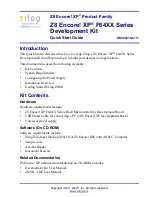...the world's most energy friendly microcontrollers
2014-07-02 - Gecko Family - d0001_Rev1.30
136
www.silabs.com
14 EBI - External Bus Interface
0 1 2 3
4
EBI
(EFM32)
Ex t ernal
Async.
Device
Parallel Int erface
Quick Facts
What?
The EBI is used for accessing external
parallel devices. The devices appear as a
part of the EFM32G's internal memory map
and are therefore extremely simple to use.
Why?
Even though the EFM32G is versatile, there
might be a need for specific external devices
such as extra RAM, FLASH, LCD. The EBI
simplifies the access to such devices.
How?
Through memory mapping the devices
appear as a part of the internal memory map.
When the processor performs read or writes
to the address range of the EBI, the EBI
handles the data transfers to and from the
external devices. The EBI may be interfaced
by the DMA, thus enabling operation in EM1.
14.1 Introduction
The External Bus Interface provides access to external parallel interface devices such as SRAM, FLASH,
ADCs and LCDs. The interface is memory mapped into the address bus of the Cortex-M3. This enables
seamless access from software without manually manipulating the IO settings each time a read or write
is performed. The data and address lines multiplexed in order to reduce the number of pins required to
interface the external devices. The bus timing is adjustable to meet specifications of the external devices.
The interface is limited to asynchronous devices.
14.2 Features
• Programmable interface for various memory types
• 4 memory bank regions
• Individual chip select line (EBI_CSn) per memory bank
• Accurate control of setup, strobe, hold and turn-around timing
• Individual active high / active low setting of interface control signals
• Slave read/write cycle extension
• •
• Up to 16-bit data bus width
14.3 Functional Description
An overview of the EBI module is shown in .
The EBI has multiplexed and non-multiplexed addressing modes. Fastest operation is achieved when
using a non-multiplexed addressing mode. The multiplexed addressing modes are somewhat slower
and require an external latch, but they use a significantly lower number of pins. The use of the 16 EBI_AD
pin connections depends on the addressing mode. They are used for both address and data in the
Summary of Contents for EFM32G
Page 505: ......


















